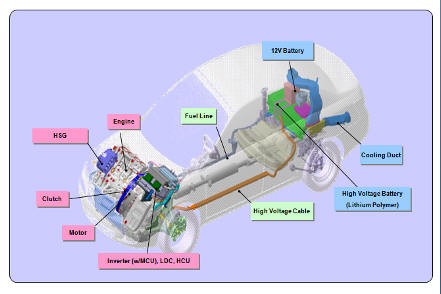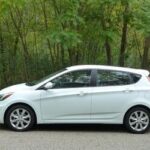Hyundai, a leader in fuel efficiency, introduced the 2011 Sonata Hybrid featuring the groundbreaking Hybrid Blue Drive system. This innovative technology, entirely developed in-house, boasts several industry firsts, setting the Sonata Hybrid apart with remarkable performance and efficiency.
Hyundai’s Hybrid Blue Drive: A Deep Dive
The 2011 Sonata Hybrid utilizes a full parallel hybrid system, allowing for zero-emission, all-electric driving at speeds up to 72 mph. It seamlessly transitions to a blended gas-electric mode at any speed, and the engine shuts down at stops to eliminate idle fuel consumption and emissions.
Lithium Polymer Battery: A Game Changer
A key component of the Hybrid Blue Drive system is the world’s first automotive application of a lithium polymer battery. This lightweight, compact battery offers superior performance compared to traditional nickel-metal hydride batteries.
The lithium polymer battery boasts a 20-30% weight reduction, 40% smaller volume, and 10% greater efficiency. Its manganese spinel chemistry ensures thermal stability and eliminates the need for replacement during the vehicle’s lifespan. This advanced battery technology enables extended electric driving, quicker acceleration, and reduced self-discharge.
Transmission-Mounted Electric Drive (TMED): Redefining Hybrid Architecture
The Sonata Hybrid’s Transmission-Mounted Electric Drive (TMED) architecture distinguishes it from competitors. By separating the electric motor from the transmission gear-set, Hyundai achieved significant design flexibility and efficiency gains.
This innovative layout allows for interchangeable electric motors and transmissions, optimizing performance for various vehicle types. The TMED architecture also contributes to the Sonata Hybrid’s impressive highway fuel economy by minimizing motor rotational speed and reducing energy loss.
Six-Speed Automatic Transmission: Efficiency Meets Performance
Unlike other hybrids relying on complex and less efficient continuously variable transmissions (CVTs), the 2011 Sonata Hybrid features a conventional six-speed automatic transmission. This choice enhances mechanical efficiency and contributes to the car’s overall performance.
Hyundai engineers overcame the challenges of integrating an electric motor with a step-ratio transmission, resulting in a seamless and efficient driving experience.
Hybrid Starter-Generator (HSG) and Regenerative Braking: Maximizing Efficiency
The Hybrid Starter-Generator (HSG) plays a crucial role in the Sonata Hybrid’s efficiency. It starts the engine, charges the hybrid battery, and enables smooth, silent electric starts. The system also incorporates regenerative braking, capturing kinetic energy during deceleration to recharge the battery and extend brake pad life.
2.4-Liter Theta II Engine and Thermal Management: Optimized for Performance and Efficiency
The 2.4-liter Theta II engine, calibrated for the Atkinson cycle, works in harmony with the electric motor to deliver optimal power and efficiency. A sophisticated thermal management system with independent cooling circuits ensures optimal operating temperatures for all powertrain components.
Aerodynamics and Lightweight Design: Enhancing Fuel Efficiency
The 2011 Sonata Hybrid boasts a sleek, aerodynamic design with a drag coefficient of 0.25, contributing to its exceptional highway fuel economy. Its lightweight construction, including the lithium polymer battery, further enhances efficiency.
The 2011 Sonata Hybrid showcases Hyundai’s commitment to innovation and fuel efficiency. Its advanced technologies, including the Hybrid Blue Drive system and lithium polymer battery, combined with a lightweight design and aerodynamic profile, deliver an exceptional driving experience with unparalleled fuel economy for its class.


